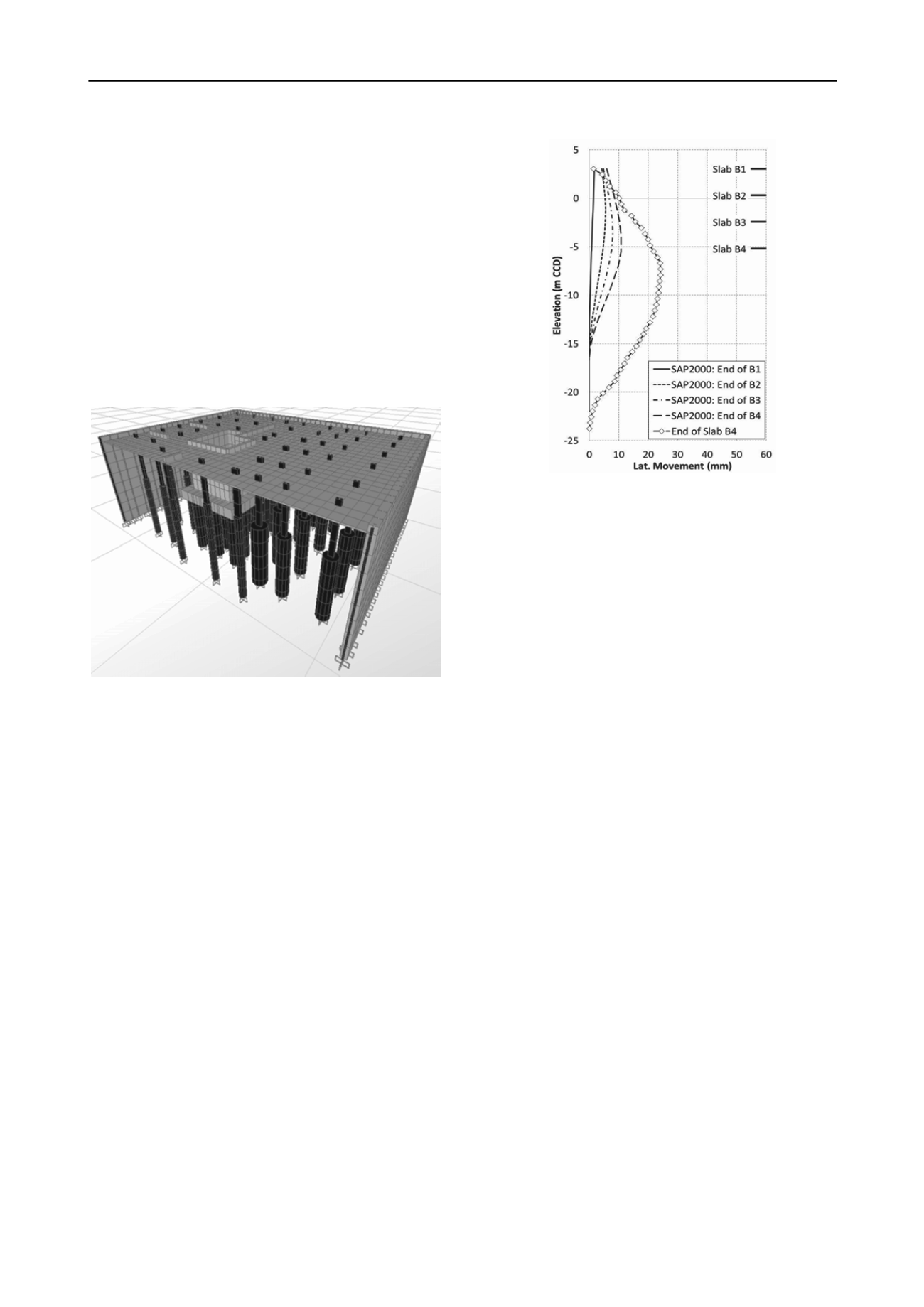
1978
Proceedings of the 18
th
International Conference on Soil Mechanics and Geotechnical Engineering, Paris 2013
finite element simulations of the top-down construction process
were conducted using SAP2000. The nonlinear time-dependent
concrete effects of shrinkage, creep and variation of the
modulus of elasticity with time were considered in the analysis.
The analysis was performed in a step-by-step basis for the entire
construction sequence using nonlinear stage construction
without geometric nonlinearity.
Figure 6 shows the model after the first basement level was
placed. The reinforced concrete columns and caissons were
modeled as frame elements whereas the basement slabs, secant
walls, foundation mat, corewalls, and interior shear walls were
modeled as thin shell elements. The cross section of the secant
walls consisted of concrete elements with embedded wide
flange sections (W24, W33) and was modeled using an
equivalent thickness based on the transformed section.
Structural loads were applied, but lateral earth loads were not.
Figure 7. Computed time-dependent and observed lateral
movements after slab B4 placed at OMPW
1. Top-down excavations in clays can be expected to result
in normalized horizontal movements of approximately
0.15 to .2% when the uppermost slab is placed close to
the ground surface so as to minimize the cantilever
movements associated with the excavation process.
2. Of these “top-down” movements, approximately 40 %
could be attibuted to the time-dependent response of the
concrete floor slabs.
3. Other construction activities or expedient excavation
procedures led to movements that constituted 60 to 75%
of the total movements that developed during
construction. Use of precedence in estimating ground
movements must be tempered by a realization of other
site activities that can lead to ground movements.
Figure 6. Model for time-dependent slab response at OMPW
The concrete was assumed isotropic with compressive
strength taken from the as-built structural drawings and verified
with the concrete reports provided by the contractor. The time-
dependent behavior of concrete was included only for the
basement slabs. The concrete properties were calculated based
on standard concrete practice methods defined in ACI (2011)
for a Poisson ratio of 0.2. The nonlinear variation of shrinkage
with time was based on average values of the standard concrete
practice codes: ACI 209, CEB-FIP 1990, AASHTO LRFD
2010, AS3600-2009, and NEN 6720.
6 ACKNOWLEDGEMENTS
Financial support for this work was provided by National
Science Foundation grant CMMI-0928184 and the
Infrastructure Technology Institute of Northwestern University.
The results of the analyses are given in Figure 7, where
both the computed time-dependent movements of the walls at
the end of each slab placement stage are compared to the total
lateral movements of an inclinometer 1 m behind the wall. The
lateral movements shown correspond to those that developed
after the excavation to the first slab level was made, so that one
can directly see the contributions of the time-dependent
movements to the lateral deformations. About 40% of the
lateral movements can be attributed to the time dependent
effects of the concrete slabs.
7 REFERENCES
American Concrete Institute (2011), "Building Code Requirements for
Structural Concrete (ACI 318-11) and Commentary," Farmington
Hills, MI.
Arboleda, L. (2013). “Influence of time-dependent effects on
movements associated with top-down excavations,” PhD
dissertation, Northwestern University, Evanston, IL
Chung, C.-K. and Finno, R.J., "Influence of depositional processes on
the geotechnical parameters of Chicago glacial clays," Engineering
Geology, 32, 1992, 225-242.
Kern, K. (2011). “Analysis of top-down construction at the Block 37
project in Chicago Il,” MS thesis, Northwestern University,
Evanston, IL
7 CONCLUSION
Based on the results of the data and analyses summarized
herein, the following conclusions can be drawn regarding these
two excavations:
Kung, G. T.-C. ( 2009). “Comparison of excavation-induced wall
deflection using top-down and bottom-up construction methods in
Taipei silty clay,” Computers and Geotechnics, Volume 36, Issue 3,
April, 373-385.
Long, M. (2001) “Database for retaining wall and ground movements
due to deep excavations, “
J Geotech Geoenviron Eng, ASCE,
127
(3), 203–224.
Sarabia, F. (2012). “Hypoplastic constitutive law adapted to simulate
excavations in Chicago glacial clays,” PhD thesis, Northwestern
University, Evanston, IL


